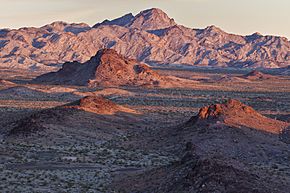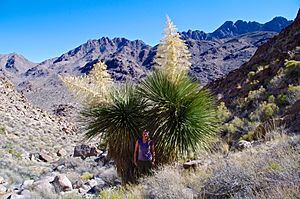Chemehuevi Mountains facts for kids
Quick facts for kids Chemehuevi Mountains |
|
|---|---|

Much of the Chemehuevi's
showing Chemehuevi Peak and parts of the Chemehuevi Valley (view approx. north-northwest) |
|
| Highest point | |
| Peak | Chemehuevi Peak |
| Elevation | 3,694 ft (1,126 m) |
| Geography | |
| Country | United States |
| Settlements | Topock, Arizona, Needles, California and Lake Havasu City, Arizona |
| Range coordinates | 34°37′30.031″N 114°31′32.863″W / 34.62500861°N 114.52579528°W |
| Topo map | USGS Chemehuevi Peak |
The Chemehuevi Mountains are a mountain range in southeastern California. They are located right next to the Colorado River, which forms the border with Arizona. These mountains are in San Bernardino County, south of a town called Needles, California. They stretch about 15 miles from north to south.
Contents
Where are the Chemehuevi Mountains?
The Chemehuevi Mountains are found between U.S. Route 95 and the Topock Gorge of the Colorado River. They are just south of Interstate 40, a major highway.
Important Peaks and Valleys
At the northern end of the range, you'll find Whale Mountain. It stands about 2,774 feet (846 meters) tall. The highest point in the entire range is Chemehuevi Peak. This peak reaches 3,694 feet (1,126 meters) high. It is located at the far southwest part of the mountains. Chemehuevi Peak borders the Chemehuevi Valley and Chemehuevi Wash, where the valley turns east to meet the Colorado River.
Exploring the Chemehuevi Mountains Wilderness
A special area called the Chemehuevi Mountains Wilderness Area protects these rugged mountains. The mountains are made of a type of rock called granite, which is very strong.
What Does the Wilderness Look Like?
The mountain range is shaped like a horseshoe, with the open part facing east towards the Colorado River. Inside this horseshoe shape, there is a large valley. This valley has low, rolling hills. These hills are covered with many types of desert plants. You can see different kinds of cacti, like cholla, and tall, spiky plants called ocotillo. Sometimes, you might even spot an agave plant.
Colors of the Mountains
If you look at the mountains from the west, you'll notice how light-colored, almost white, the granite peaks are. They stand out against the green creosote bushes and cacti that cover the lower slopes. Closer to the Colorado River, the mountains change. The rocks become dark red and gray, forming volcanic spires and flat-topped mesas.



